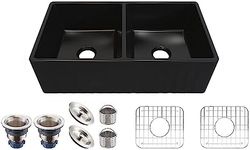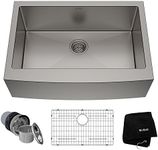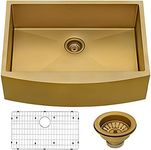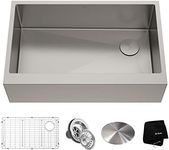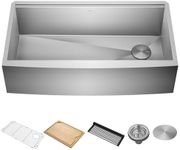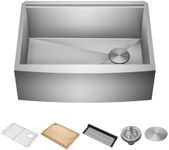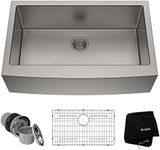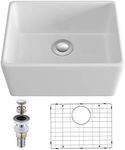Buying Guide for the Best Farmhouse Sinks
Choosing a farmhouse sink is about blending style, function, and durability to fit your kitchen needs. Farmhouse sinks, also known as apron-front sinks, are popular for their deep basins and exposed fronts, making them both a design statement and a practical choice for busy kitchens. When shopping for one, it's important to consider how you use your kitchen, the space available, and the look you want to achieve. Understanding the key features will help you select a sink that not only looks great but also makes your daily kitchen tasks easier.MaterialThe material of a farmhouse sink affects its durability, appearance, and maintenance needs. Common materials include fireclay, stainless steel, cast iron, and copper. Fireclay is known for its classic look and resistance to scratches and stains, while stainless steel is lightweight and easy to clean but may show water spots. Cast iron sinks are heavy and durable with a glossy enamel finish, but they can chip if hit hard. Copper sinks offer a unique look and develop a patina over time, but require more care to maintain their appearance. When choosing, think about how much use your sink will get, how much maintenance you're willing to do, and the style of your kitchen.
Size and DepthThe size and depth of a farmhouse sink determine how much you can fit inside and how comfortable it is to use. Sinks typically range from 24 to 36 inches wide and can be 8 to 10 inches deep. Smaller sinks are suitable for compact kitchens or if you don't do a lot of large-scale cooking, while larger and deeper sinks are ideal for washing big pots and pans or if you have a large family. Measure your cabinet space carefully and consider your cooking habits to pick the right size and depth for your needs.
Number of BasinsFarmhouse sinks come in single or double basin designs. A single basin offers a large, uninterrupted space, making it easy to wash big items, while a double basin provides two separate areas for multitasking, such as washing dishes on one side and rinsing vegetables on the other. If you often handle large cookware or bakeware, a single basin might be more convenient. If you prefer to keep tasks separate or often wash dishes by hand, a double basin could be a better fit.
Installation TypeThe installation type refers to how the sink is mounted in your countertop. Most farmhouse sinks are apron-front, meaning the front of the sink is exposed and extends slightly beyond the edge of the counter. Some require custom cabinetry or modifications to existing cabinets. There are also undermount and flush-mount options, which affect the look and how easy it is to clean around the sink. Consider your current kitchen setup and whether you're willing to make changes to accommodate the sink.
Finish and ColorThe finish and color of your farmhouse sink can impact both its appearance and how well it hides stains or scratches. White and off-white are classic choices, especially in fireclay and cast iron, but stainless steel, black, and copper finishes are also available for a more modern or rustic look. Lighter colors can show stains more easily, while darker finishes may hide marks but show water spots. Choose a finish and color that matches your kitchen style and your willingness to keep it looking clean.
